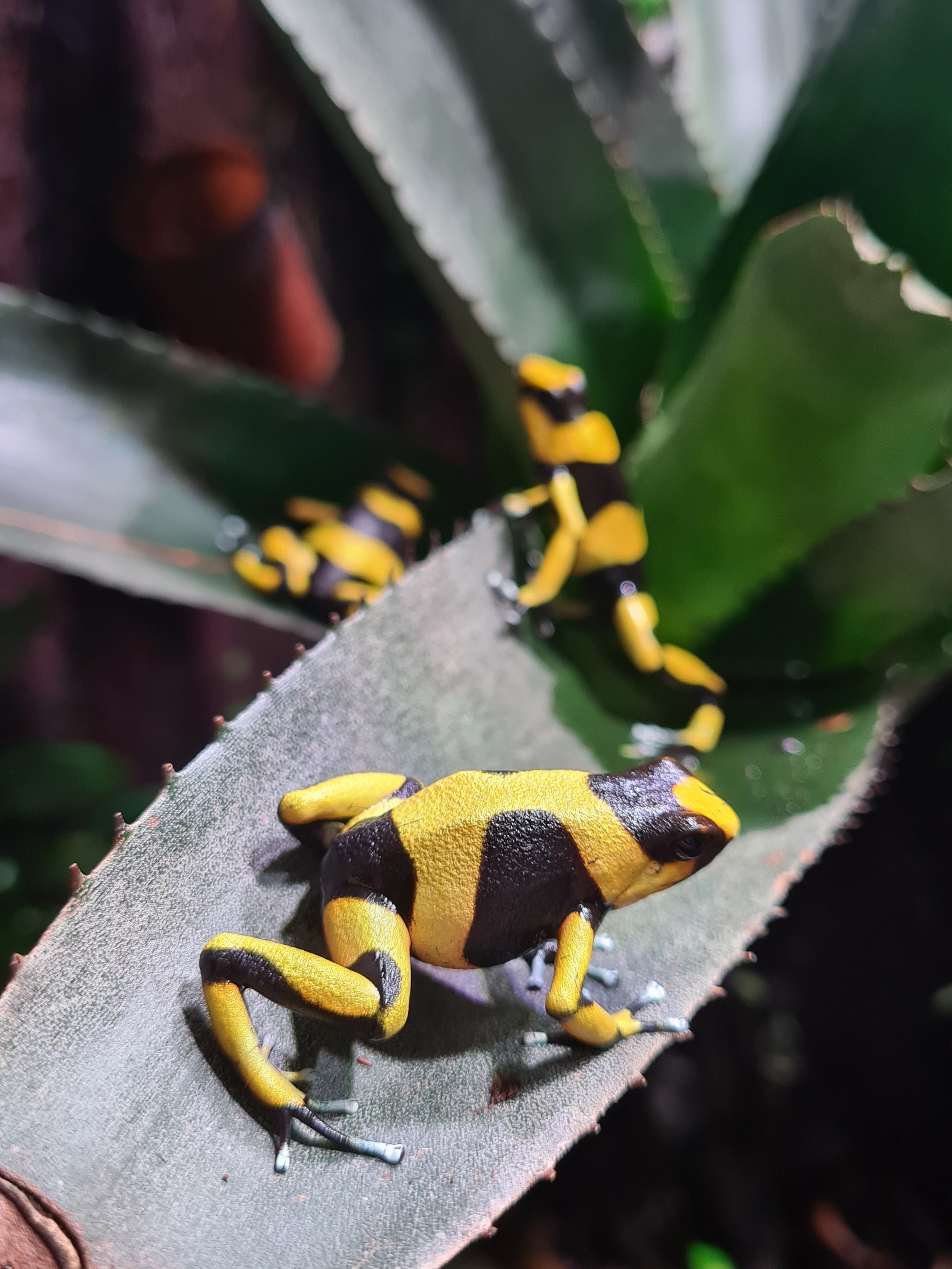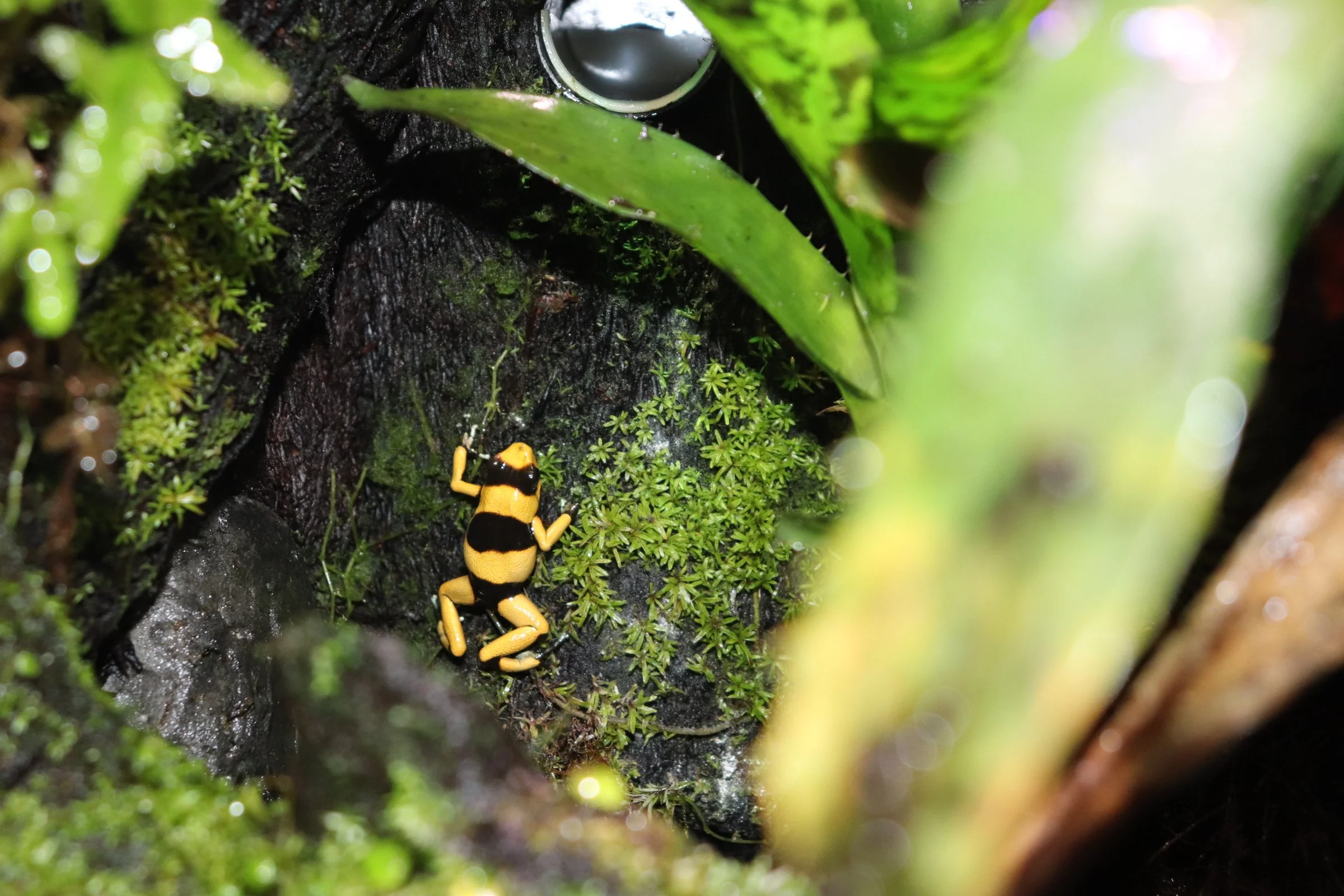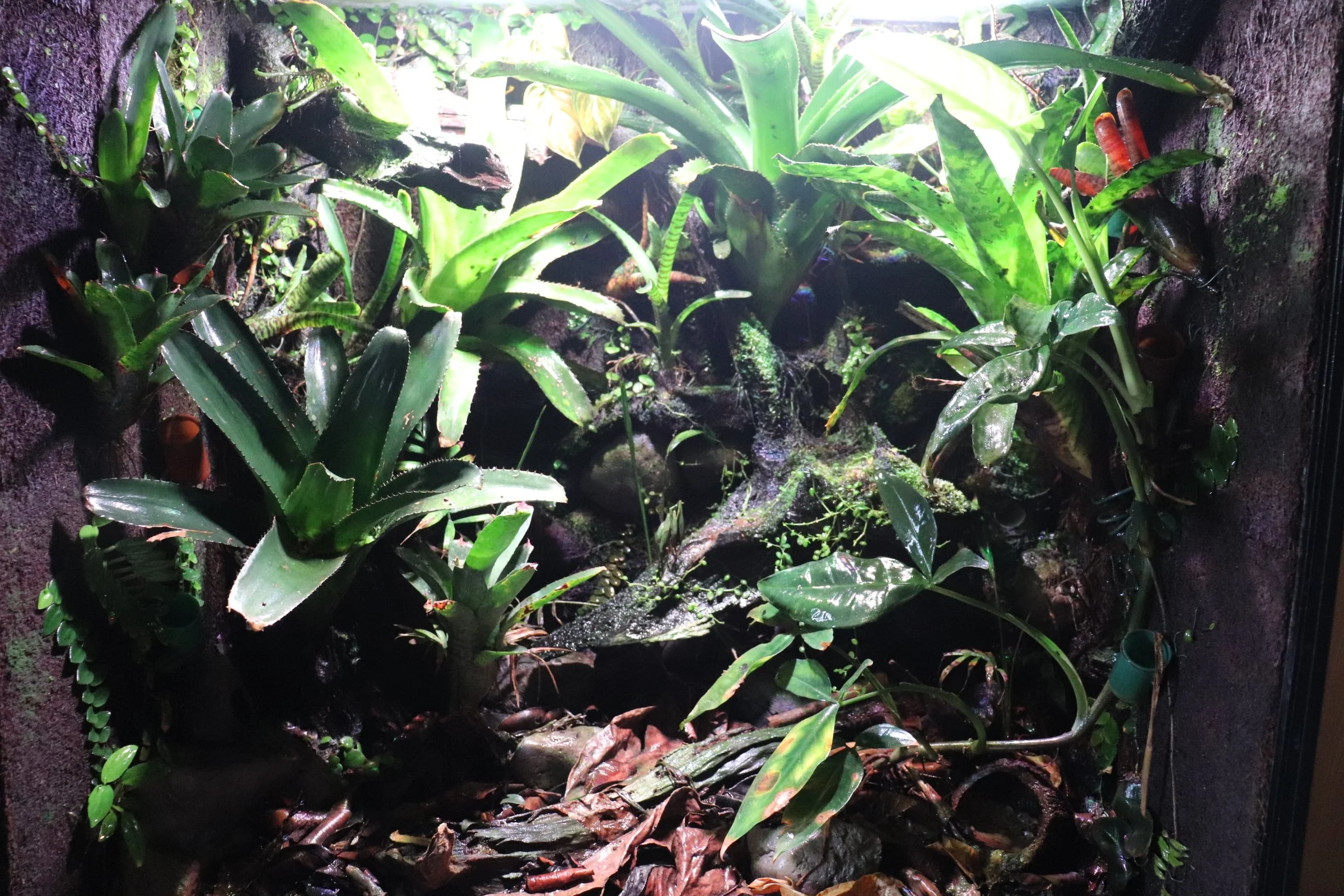When life gives you Lehmann’s…
Discussing the care and keeping of Oophaga lehmanni with Ross Dacre
Lehmann's poison frog (Oophaga lehmanni) is a critically endangered species of Dendrobatidae endemic to the Valle de Cauca, Colombia. There are several populations of this species, but their total distribution ranges no more than 10km2. This means the species is extremely vulnerable to deforestation and sustainable captive breeding may provide a final lifeline. To support global breeding projects, an organisation called ‘Tesoros de Colombia’ began producing large numbers of rare Colombian Dendrobatids in-situ and legally distributing captive-bred animals across the world. Now, keepers in the UK are beginning to establish healthy breeding colonies, driving down the demand for poached specimens and improving our understanding of these unique frogs.
Oophaga
Ross Dacre is a herpetoculturist with a fascination for poison frogs and has been keeping and breeding Dendrobatids for over 12 years. Recently, he successfully bred the yellow locality of the Lehmann’s poison frog, in what is thought to be a UK first. Ross told Exotics Keeper Magazine: “Oophaga lehmanni is a relatively large frog in the Dendrobatid world, with adults reaching approximately 3 and a half centimetres from snout to vent. These unique frogs have little to concern them in the wild due to their toxicity and aposematic colouration, warning any would-be predator of their unpalatable nature. Their colouration and, to an extent, pattern vary depending on their locality in the wild. Separate locales of red, yellow, and orange all with a base colour of brown to black banding can be found, with their white toe tips glistening amongst the leaves.”
The rainforests of Colombia host many different species of poison frogs, including seven distinct species from the Oophaga genus. These animals are extremely diverse in their colouration and some species have only been described within the last 50 years. One of these is the Anchicaya poison frog (Oophaga anchicayensis) which was only described in 2018. Ross continued: “Oophaga lehmanni and Oophaga histrionica are parapatric species and where contact areas occur in the wild interbreeding between the two happens. One such area is the San José de Anchicayá area where in 2018 a known mix between yellow O. lehmanni and O. histrionica was recognised as Oophaga anchicayensis.”
Although Lehmann’s poison frog is critically endangered, there has been some support for the species, which came into fruition before scientists knew of its existence. Ross continued: “On July 15th, 1968, Parque Nacional Natural Farallones de Cali was established protecting Valle de Cauca with great influence from acclaimed biologist and conservationist Federico Carlos Lehmann Valencia. It is in this biologically diverse area where all populations of O. lehmanni can be found. When describing O. lehmanni in 1976, Myers and Daly recognised the importance of such work and aptly named the red-banded frog Dendrobates lehmanni (which was later changed to Oophaga lehmanni in 2006).”
Treasures of Colombia
As a protected species, it is illegal to harvest individuals from the wild. In some cases, this can increase demand for a species, which is exactly what Tesoros de Colombia is aiming to combat. Labelled a ‘sustainable farm’, the organisation has received official licensing from the Colombian government to keep and breed several of the country’s most endangered amphibians for export. Working with conservationists, ecologists and environmental engineers, “Tesoros” can satisfy some global demand whilst having a minor impact on wild populations. Expert breeders such as Ross can source a viable pair (or group) and begin to breed good numbers of the species internationally. This not only creates a large captive population for ex-situ research but also drives global demand for wild-caught specimens down.
“I have been following the work of Tesoros De Colombia with a keen interest for many years, long before they had even exported frogs out of Colombia” added Ross. “The concept of conservation through commerce appeals to both my passion for Dendrobatidae as a hobbyist but also my respect for the need for in situ projects to ensure that captivity isn’t the only place in which future generations can enjoy these amazing creatures.”
The popularity of keeping poison frogs has increased drastically in recent decades. Although poison frogs have been kept by hobbyists since the 1980s, product development spurred by the ‘bioactive boom’ has made this much more accessible. Now, it is much easier to create a fully natural replica of the South American rainforest and thus, keepers are having much more success in keeping and breeding rare frogs. Most Dendrobatids are listed under CITES Appendix 2 which restricts trade, meaning wild-caught specimens are illegal and even captive-bred animals can be difficult to source.
Ross continued: “For the entirety of my time keeping dart frogs, it has seemed just a pipe dream to have captive-bred, ethically sourced large Oophaga from the likes of Tesoros De Colombia directly imported into the UK. To put it into perspective, I needed to travel to Holland to purchase my Phyllobates aurotaenia ‘yellow’ that are of Tesoros De Colombia origins. Then to Germany to obtain orange Phyllobates terribilis ‘blackfoot’ too but the only time I had ever seen any Oophaga from Tesoros in the flesh was at the American Frog Day 2019 and even then, I wasn’t able to acquire any. When I was contacted by Fantastic Frogs and told that they were planning the first ever shipment into the UK I jumped at the opportunity. I was then sent an availability list that consisted of dream frog after dream frog but decided on O. lehmanni ‘yellow’ based on the opportunity to support in situ conservation of a critically endangered species whilst also working towards establishing a captive population here in the UK being in my opinion, a worthy cause. I’m under no illusions that the likelihood of my frogs being reintroduced into the wild is none to zero, but I am a believer in conservation through commerce and by supporting such projects we can all benefit species long term.”
Breeding poison frogs
Given the correct conditions, many species of poison frog will breed readily in captivity. Oophaga lehmanni exhibit remarkable parental behaviours. Once the tadpoles have emerged from their eggs, which are laid on land, the parent female will transport each tadpole individually by carrying them on her back to separate water sources (most often bromeliad axils) which can be several meters up within trees. This is no mean feat for a frog that is less than one and a half inches in size. The parent female must then remember where she has placed each tadpole and return periodically to feed them to have any chance of their survival. “When broken down and translated from Greek, Oophaga (oon, phagos) means ‘egg-eater’” Ross added. “This is the name given to this genus of frogs due to the fact tadpoles within the genus are reliant on the trophic eggs from their mother for successful metamorphosis.”
“Although some success has been achieved in captivity with raising Oophaga tadpoles on both trophic eggs as well as eggs laid on land for reproduction purposes by both the parent species, as well as on other Oophaga species eggs, it has always been my intention to design a vivarium in which the whole process from egg to froglet would occur without the need for any intervention. I decided to choose bromeliads with broad, sturdy leaves to support the weight of the frogs yet also hold a large body of water in their axils such as Aechmea cucullata for breeding purposes. I only added smaller bromeliads as aesthetic accents, to create visual barriers and to make better use of the available space within the vivarium. I also added artificial tadpole deposit sites in the form of film canisters angled to constantly hold water. This meant I was able to watch the daily progress of the tadpole as it was unable to adequately hide from view unlike its siblings within bromeliad axils.”
Setting up the ideal enclosure does not guarantee tadpoles, let alone froglets. One of the major challenges for frog breeders is sexing the animals, particularly if the froglets are sourced at a young age. Across most species, these are extremely difficult to sex. However, if a viable pair are housed together it can lead to some insightful observations. Although breeding behaviours have been widely documented in other Oophaga species, making notes on the behavioural cues of the critically endangered Lehmann’s poison frog has developed Ross’ knowledge and with a sustainable captive-bred population now available in the UK, could improve wider understanding of the species.
Ross continued: “One observation that I hadn’t previously witnessed in approximately 12 years of keeping Dendrobatidae was the courting process as a whole, from calling to the laying of eggs. I was sitting watching the male calling toward what was an unsexed frog at the time, trying to judge the other frog’s reaction to help gauge its sex. Then the known male started to exhibit behaviour I hadn’t seen before, it stopped moving as it was previously stepping away from the other frog and started stamping its front foot on the bromeliad leaf, in what I can only describe as if he were saying “here is the spot”. The unsexed frog moved towards the male and began to move its back legs in a swiping motion, the movement was similar to a kick but the motion was as if it was trying to clear and or clean the surface of the leaf where the male had been stamping. The female was circling on the spot whilst doing this, often in a submissive posture. Then to my excitement, the two frogs positioned themselves vent to vent in independent amplexus and the unsexed frog began to lay eggs!”
Sustainable sourcing
Sustainability is a popular concept for many industries in 2022. Unfortunately, the unsustainable practices of deforestation and agriculture rarely make consideration for the delicate fauna they threaten. Nonetheless, exotics keepers should be extra vigilant when it comes to sourcing animals. Pet keepers who have no intention of breeding their animals should always source captive-bred specimens. Breeders may require wild-caught animals to diversify their bloodlines, but where possible, captive-bred specimens should always be prioritised. In the case of critically endangered species, sourcing animals from a respected breeding facility can ensure that sustainability is put at the forefront of the breeding initiative.
“When making the reservation for my frogs, I purchased them as a group of 4 unsexed juveniles in the hope I would be lucky enough to end up with at least one pair” explains Ross. “However, due to the bureaucracy involved with importing species from Colombia, not least for the first time into the country, the timescale involved was long enough for my frogs to arrive with me knowing that I had at least one female, as it had laid eggs shortly before shipping. After arriving home, I heard calling from the vivarium. Which, to my delight, meant I had at least one pair. I have since proven out the known female too as I have witnessed her carrying tadpoles as well as feeding trophic eggs to them once deposited in water and I have also witnessed another frog lay eggs on land. So, I know with certainty I have a ratio of 1.2.1” (1 male, 2 females, 1 unsexed).
Ross is hoping to keep his juvenile frogs until they can be sexed. Most poison frogs take upwards of one year before the keeper can make an informed decision on the sex of the animal. By identifying the mother frog and holding back the froglets, he will eventually be able to pair the youngsters with a genetically viable partner. Once Ross has secured 2 breeding pairs, it is likely that O. Lehmanni ‘yellow’ will become more available in the hobby over the coming years. Ross added: “when the original 4 arrived on these shores, there were more pandas in the UK than there were Oophaga lehmanni ‘yellow’ and if I was to lose my only known male then any hope for establishing them within the UK would ride solely on one of my current offspring being a male.”







